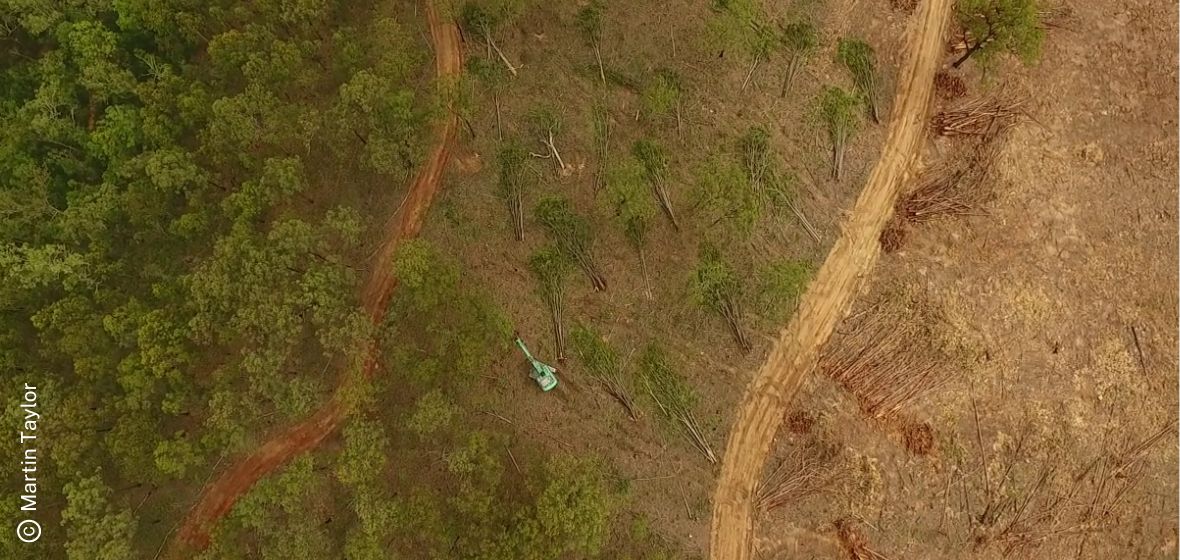
10 September 2024
Hannah Thomas, a Project Officer with Wildlife Queensland, recently published a paper in the journal Conservation Biology. The study assessed current deforestation activities in Queensland and the Northern Territory, a region with significant deforestation and globally important ecosystems.
Hannah and her fellow researchers developed a new framework to measure the effectiveness of current legislation in curbing deforestation. They discovered that current policies are not doing enough to protect Australia’s forests and that urgent changes are needed.
Widespread noncompliance with environmental laws
Deforestation continues to be a major environmental concern globally despite various laws protecting forests. Queensland, in particular, has had the highest rates of deforestation in Australia for decades.
“Habitat loss is one of the biggest threats facing wildlife in Australia. We cannot begin to halt and recover nature with such high deforestation rates,” Hannah emphasises.
The researchers used the new assessment framework to examine 1.6 million hectares of cleared land in northern Australia. They found that 65% may be potentially noncompliant with at least one environmental law. Many clearing events had no publicly available evidence of a referral to Australia’s national environmental law, the Environment Protection and Biodiversity Conservation (EPBC) Act.
Exemptions fuelling the problem
In Queensland, three-quarters of the land clearing examined was permitted through exemptions under the Vegetation Management Act (VMA). A large portion of this was due to the clearing of unregulated regrowth, with 82% of the cleared regrowth areas being middle-aged or maturing forests (e.g., greater than 15 years since clearing).
These older forests are important for biodiversity and ecosystem services and clearing them raises serious questions about whether such exemptions align with Australia’s international promises, like the Glasgow Leaders’ Declaration on Forests and Land Use, which aims to halt deforestation by 2030.
Australia isn’t alone in using exemptions to allow deforestation. Countries like Brazil and Indonesia do something similar, usually to maintain production on agricultural land. However, if clearing involves older forests that aren’t part of a regular clearing cycle, this can lead to unintended environmental damage.
What can be done?
The need for stronger laws and better enforcement
The study highlights the need for stronger enforcement of environmental laws to reduce deforestation in northern Australia. In particular, the EPBC Act needs to be updated to fix its weaknesses. A recent review of the Act pointed out the need for better compliance mechanisms, as well as the importance of considering the cumulative impacts of deforestation on biodiversity.
One key issue is that many landowners either don’t know about the EPBC Act or don’t fully understand what’s required of them. Educating farmers about their legal responsibilities, along with stricter enforcement of the laws, could help improve the situation and reduce potential non-compliance.
Balancing economic growth and environmental protection
The researchers suggest one of the biggest challenges in tackling deforestation is balancing economic growth with protecting the environment. This conflict is especially visible in northern Australia, where agriculture and resource extraction are expanding, putting extra pressure on forests.
While closing exemptions and tightening regulations might seem like a straightforward solution, the study suggests a more balanced approach. Providing incentives for landowners to keep regrowth forests, such as environmental stewardship programs, could work better than simply enforcing stricter rules. However, these programs will need to be well-designed and properly funded to make a real difference.
“Many forests in Queensland occur on private land. We need to improve stewardship schemes to incentivise and support private landholders to retain forests on their property, particularly those that provide habitat for threatened species,” says Hannah Thomas.
Urgent reforms needed
The study’s findings show just how complicated the fight against deforestation is. While current laws aim to protect the environment, gaps in enforcement and extensive legal exemptions allow deforestation to continue at an alarming pace.
The paper highlights that urgent reforms are needed to meet international commitments and safeguard Australia’s biodiversity. Strengthening laws, improving enforcement, and encouraging sustainable land management are all critical steps toward protecting our forests for future generations.
In conclusion, Wildlife Queensland is proud to share Hannah’s research and hopes the findings initiate change, helping Australia shed the embarrassing title of being the only deforestation hotspot among developed nations.
- For more details on this research, please refer to Hannah’s paper: The Society for Conservation Biology (wiley.com) and Hannah’s article in The Conversation: Poor compliance and broad exemptions mean land clearing continues apace in northern Australia – despite our laws and pledges (theconversation.com)
- Voice your concerns to the Queensland Minister for the Environment and the Great Barrier Reef and Minister for Science and Innovation, the Hon. Leanne Linard MP.
